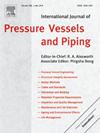Evaluation microstructure and corrosion behavior of different keyhole TIG welded joints of duplex stainless steel grade 2205 pipe
IF 3
2区 工程技术
Q2 ENGINEERING, MECHANICAL
International Journal of Pressure Vessels and Piping
Pub Date : 2025-02-08
DOI:10.1016/j.ijpvp.2025.105459
引用次数: 0
Abstract
To analyze how the chemical composition and heat input influence the microstructure, mechanical properties, and corrosion resistance of the 2205 Duplex stainless steel (DSS) weld metal, different 2205 DSS pipeline weld joints were fabricated by the K-TIG welding process with and without 2209 filler metal. Subsequently, a comparative analysis on the microstructure evolution and corrosion behavior was systematically conducted. The result show that the microstructure of the weld metal (WM) in different welding joints primarily is consisted of the ferrite matrix, grain boundary austenite (GBA), widmänstten austenite (WA), and intergranular austenite (IGA). The cover weld of K-TIG-Wire joints contains a higher volume of austenite and predominantly IGA, compared to other joints. In addition, from EBSD observations, it was found that the grain size in the root weld of the K-TIG + Wire joint is slightly refined. Meanwhile, the low angle grain boundaries (LAGBs, 2°≤ θ ≤ 5°) increased from 0.02 to 0.24 in the root weld of the K-TIG + Wire joint when compare to that of WM in the K-TIG joint. Besides, the Vickers hardness of the cover weld metal (WM) in K-TIG + Wire joints is significantly higher than that of other specimens, attributed to higher alloy element and austenite phase content. Based on the results obtained from corrosion testing and the subsequent analysis of the corroded morphologies, the corrosion resistance of the samples can be ordered as follows: Cover WM of K-TIG + Wire > Root WM of K-TIG + Wire > WM of K-TIG. These results indicate that the higher alloy content of the filling wire and heat input of the multi-pass welding process exerts a significantly positive effect on the mechanical and corrosion properties of the 2205 DSS WM.
2205双相不锈钢管不同锁孔TIG焊接接头的组织与腐蚀行为评价
为了分析化学成分和热输入对2205双相不锈钢(DSS)焊缝金属的组织、力学性能和耐腐蚀性的影响,采用K-TIG焊接工艺制备了不同2205双相不锈钢(DSS)管道焊缝接头。随后,系统地进行了组织演变和腐蚀行为的对比分析。结果表明:不同焊接接头焊缝金属组织主要由铁素体基体、晶界奥氏体(GBA)、widmänstten奥氏体(WA)和晶间奥氏体(IGA)组成;与其他接头相比,K-TIG-Wire接头的覆盖焊缝中含有较多的奥氏体和IGA。此外,通过EBSD观察发现,K-TIG + Wire接头根部焊缝的晶粒尺寸略有细化。与此同时,K-TIG + Wire接头根焊缝的低角晶界(LAGBs, 2°≤θ≤5°)较WM在K-TIG接头中的低角晶界从0.02增加到0.24。此外,由于K-TIG + Wire接头中合金元素和奥氏体相含量较高,覆盖焊缝金属(WM)的维氏硬度明显高于其他试样。根据腐蚀试验结果和随后的腐蚀形态分析,样品的耐蚀性可按以下顺序排列:K-TIG +钢丝的覆盖WM >;K-TIG +线材根WM >;K-TIG的WM。结果表明,较高的填充丝合金含量和多道次焊接过程的热输入对2205 DSS WM的力学性能和腐蚀性能有显著的积极影响。
本文章由计算机程序翻译,如有差异,请以英文原文为准。
求助全文
约1分钟内获得全文
求助全文
来源期刊
CiteScore
5.30
自引率
13.30%
发文量
208
审稿时长
17 months
期刊介绍:
Pressure vessel engineering technology is of importance in many branches of industry. This journal publishes the latest research results and related information on all its associated aspects, with particular emphasis on the structural integrity assessment, maintenance and life extension of pressurised process engineering plants.
The anticipated coverage of the International Journal of Pressure Vessels and Piping ranges from simple mass-produced pressure vessels to large custom-built vessels and tanks. Pressure vessels technology is a developing field, and contributions on the following topics will therefore be welcome:
• Pressure vessel engineering
• Structural integrity assessment
• Design methods
• Codes and standards
• Fabrication and welding
• Materials properties requirements
• Inspection and quality management
• Maintenance and life extension
• Ageing and environmental effects
• Life management
Of particular importance are papers covering aspects of significant practical application which could lead to major improvements in economy, reliability and useful life. While most accepted papers represent the results of original applied research, critical reviews of topical interest by world-leading experts will also appear from time to time.
International Journal of Pressure Vessels and Piping is indispensable reading for engineering professionals involved in the energy, petrochemicals, process plant, transport, aerospace and related industries; for manufacturers of pressure vessels and ancillary equipment; and for academics pursuing research in these areas.

 求助内容:
求助内容: 应助结果提醒方式:
应助结果提醒方式:


